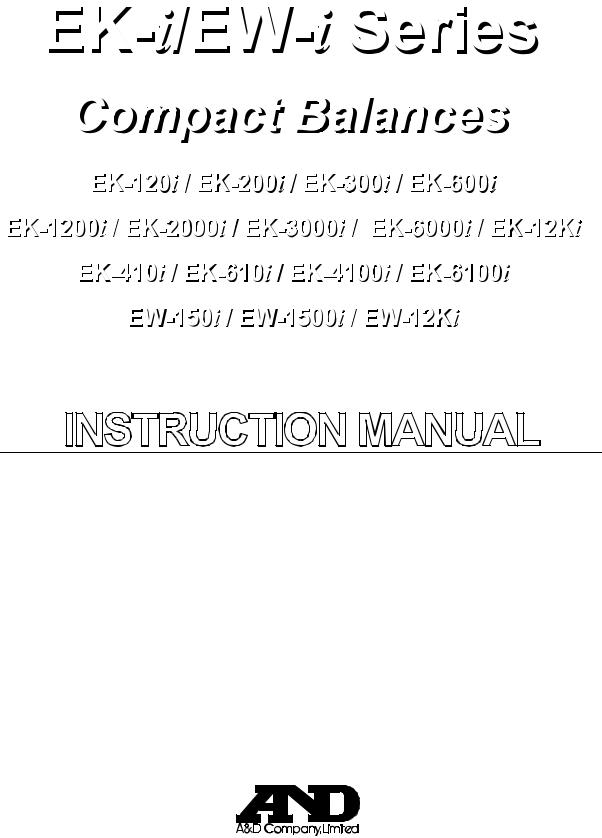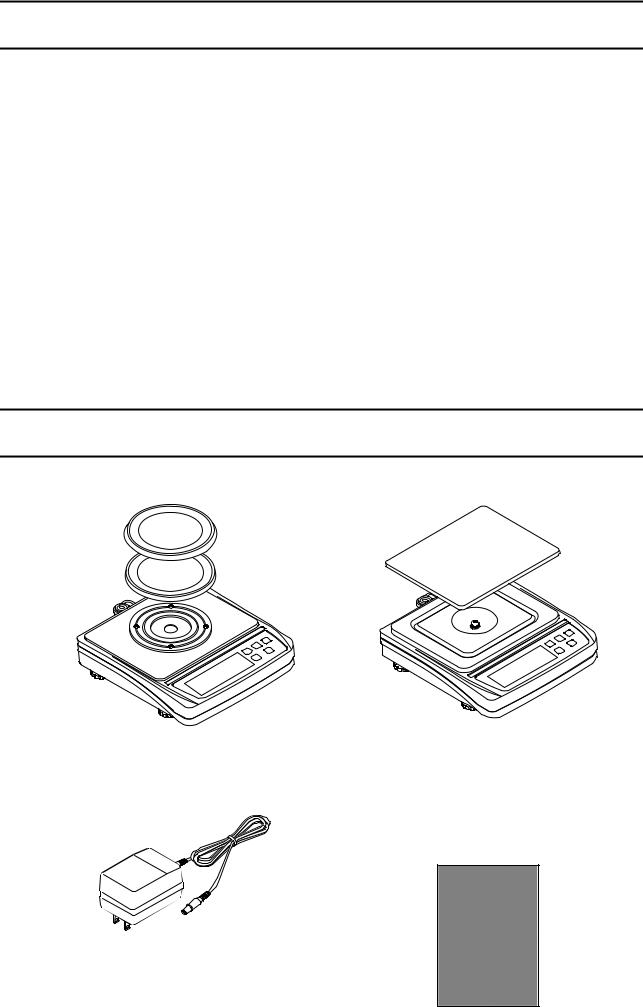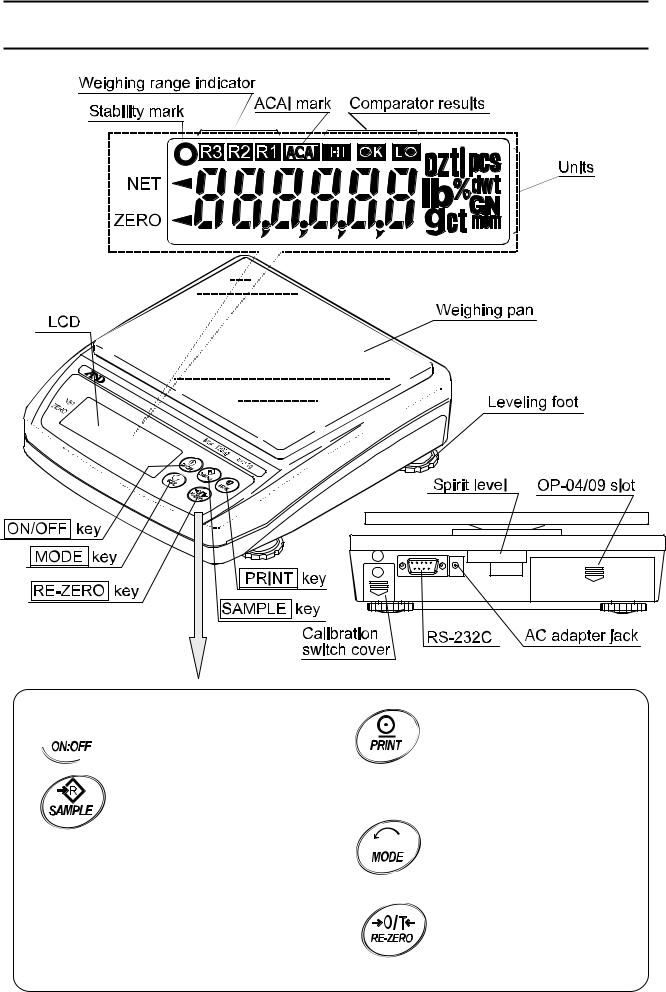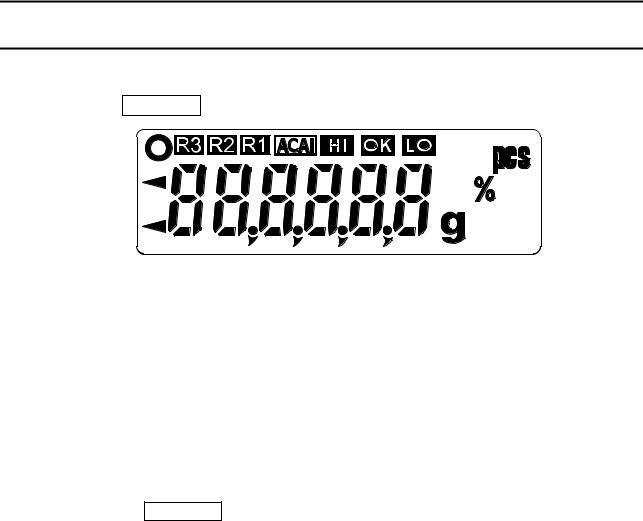A&D Weighing EK-120i, EK-200i, EK-300i, EK-600i, EK-1200i A&D-EKseriesBalanceIM.pdf Instruction Manual
...
x
1WMPD4000465B

© 2011 A&D Company, Limited. All rights reserved.
No part of this publication may be reproduced, transmitted, transcribed, or translated into any language in any form by any means without the written permission of A&D Company, Limited.
The contents of this manual and the specifications of the instrument covered by this manual are subject to change for improvement without notice.
COMPLIANCE WITH FCC RULES
Please note that this equipment generates, uses and can radiate radio frequency energy. This equipment has been tested and has been found to comply with the limits of Class A computing device pursuant to Subpart J of Part 15 of FCC rules. These rules are designed to provide reasonable protection against interference when the equipment is operated in a commercial environment. If this unit is operated in a residential area it may cause some interference and under these circumstances the user would be required to take, at his own expense, whatever measures are necessary to eliminate the interference.
(FCC = Federal Communications Commission in the U.S.A.)
Note
Under some ambient electromagnetic conditions, this equipment may be affected by the electromagnetic interference.
This is a hazard alert mark.

CONTENTS
1. INTRODUCTION ............................................................................................................. |
3 |
2. UNPACKING ................................................................................................................... |
3 |
3. PART NAMES AND FUNCTIONS................................................................................... |
4 |
4. SETTING UP ................................................................................................................... |
5 |
4-1. Setting up your balance ................................................................................................................. |
5 |
4-2. Power source................................................................................................................................. |
5 |
5. OPERATION.................................................................................................................... |
6 |
5-1. Turning the power ON and OFF..................................................................................................... |
6 |
5-2. LCD backlight ................................................................................................................................ |
6 |
5-3. Units .............................................................................................................................................. |
7 |
5-4. Selecting a weighing unit ............................................................................................................... |
8 |
5-5. Basic operation.............................................................................................................................. |
8 |
5-6. Weighing range for the EW-i series ............................................................................................... |
9 |
5-7. Counting mode (pcs) ................................................................................................................... |
10 |
5-8. Percent mode (%)........................................................................................................................ |
11 |
6. COMPARATOR ............................................................................................................. |
12 |
6-1. Setting example........................................................................................................................... |
12 |
7. CALIBRATION .............................................................................................................. |
14 |
7-1. Calibration using a weight............................................................................................................ |
14 |
7-2. Gravity acceleration correction .................................................................................................... |
16 |
8. FUNCTIONS.................................................................................................................. |
17 |
8-1. Key operation .............................................................................................................................. |
17 |
8-2. Entering the function setting mode .............................................................................................. |
17 |
8-3. Setting example........................................................................................................................... |
18 |
8-4. Storing weighing units.................................................................................................................. |
19 |
8-5. Function list ................................................................................................................................. |
20 |
9. RS-232C SERIAL INTERFACE..................................................................................... |
22 |
9-1. Interface specifications ................................................................................................................ |
22 |
9-2. Data format.................................................................................................................................. |
23 |
9-3. Data output mode ........................................................................................................................ |
23 |
9-4. Command mode .......................................................................................................................... |
24 |
10. ID NUMBER AND GLP................................................................................................ |
25 |
10-1. Setting the ID number................................................................................................................ |
25 |
10-2. GLP report ................................................................................................................................. |
26 |
1
11. OPTIONS..................................................................................................................... |
30 |
|
11-1. OP-04 |
Comparator relay output and buzzer .............................................................................. |
30 |
11-2. OP-07 |
Underhook assembly...................................................................................................... |
31 |
11-3. OP-09 |
Rechargeable battery pack (Ni-MH) ............................................................................... |
32 |
11-4. OP-12 |
Carrying case ................................................................................................................. |
32 |
12. MAINTENANCE .......................................................................................................... |
33 |
||
12-1. Notes on maintenance............................................................................................................... |
33 |
||
12-2. Error codes ................................................................................................................................ |
33 |
||
13. SPECIFICATIONS ....................................................................................................... |
35 |
||
13-1. |
EK-i |
series................................................................................................................................ |
35 |
13-2. |
EW-i |
series ............................................................................................................................... |
36 |
13-3. |
Other weighing units .................................................................................................................. |
37 |
|
13-4. |
Dimensions................................................................................................................................ |
38 |
|
GRAVITY ACCELERATION MAP ..................................................................................... |
39 |
||
2

1. INTRODUCTION
This manual describes how this balance works and how to get the most out of it in terms of performance.
The EK-i and EW-i series balances have the following features:
The EK-i series are high resolution type electronic balances having a resolution of 1/6,000 ~ 1/60,000.
The EW-i series are triple range balances and each range has a resolution of 1/3,000.
The balance has a counting function, % function and a comparator function.
The backlight LCD will help with use in a dimly lighted place.
The standard RS-232C serial interface can be connected to a printer or personal computer.
Using the serial interface, Good Laboratory Practice (GLP) data can be output.
The optional rechargeable battery pack (OP-09) is easy to install for cordless operation.
2. UNPACKING
When unpacking, check whether all of the following items are included:
Weighing pan |
Weighing pan |
Pan support
Main unit |
Main unit |
EW-150i |
EW-1500i / EW-12Ki |
EK-120i / EK-200i / EK-300i |
EK-600i / EK-1200i / EK-2000i |
EK-410i / EK-610i |
EK-3000i / EK-6000i / EK-12Ki |
|
EK-4100i / EK-6100i |
AC adapter |
Instruction Manual |
|
 Please confirm that the AC adapter is correct for your local voltage and receptacle type.
Please confirm that the AC adapter is correct for your local voltage and receptacle type.
3

3. PART NAMES AND FUNCTIONS


 Turns the power on or off.
Turns the power on or off.
Held down to enter the function setting mode.
Weighing mode (EW-i only):  Changes the weighing range
Changes the weighing range 

(when rng 0 is selected). pcs mode:
Enters the sample unit weight storing mode.
% mode:
Enters the 100% weight storing mode.
Outputs the weight data to a printer or computer, or enters a unit weight, 100% weight or other setting values to the balance.
Switches the weighing unit
(the weighing mode).
Clears the display to zero.
4

4. SETTING UP
4-1. Setting up your balance
1.Place the weighing pan on the main unit as shown on the previous page.
2.Adjust the level of the balance using the leveling feet. Use the spirit level to confirm.
The bubble should be in the center of the circle.
3.Calibrate your balance before use. (See “7. CALIBRATION”)
Balance location
To measure correctly, to keep the balance in good condition, and to prevent hazards, observe the following:
Do not install the balance in locations that are subject to excessive dust, breezes, vibration, large temperature fluctuations, condensation, or that may have magnetic fields.
Do not install the balance on a surface that is soft or that may cause the balance level to shift.
Do not install the balance in direct sunshine.
Do not install the balance near heaters or air conditioners.
Do not use an unstable AC power source.
Do not install the balance in a place where combustible or corrosive gases may exist.
Allow the balance to reach equilibrium with the ambient temperature before use.
Switch the power ON at least half an hour before use so that the balance can warm up.
When the balance is installed for the first time, or the balance has been moved, carry out calibration as described in “7. CALIBRATION.”
4-2. Power source
For the power source, the AC adapter or the rechargeable battery pack (OP-09:
Optional item) is available.
When using the AC adapter
Use a stable power source. To use the AC adapter, insert the AC adapter plug into the AC adapter jack on the EK/EW-i.
When using the rechargeable battery pack (OP-09)
Insert the rechargeable battery pack into the main unit.
The balance can be used continuously for about 9 hours using the battery pack.
If “Lb0” is displayed when using the battery pack, immediately stop using it, and recharge the battery pack or use the AC adapter.
See “11-3 OP-09 Rechargeable battery pack”, for instructions to install and charge the battery pack.
Be sure to charge the battery pack before using it for the first time.
5

5. OPERATION
5-1. Turning the power ON and OFF
1. Press the ON/OFF key to turn the power ON.
All of the symbols are displayed as shown above.
(About units: Only the units available will be displayed.)
The display turns off except for a weighing unit and the decimal point.
The balance waits for the weight data to become stable, and zero will be displayed with the ZERO mark (power-on zero).
The range for power-on zero is within ±10% of the weighing capacity around the calibrated zero point.
If the power is switched ON while there is a load beyond this range, the balance will be tared to zero and the NET mark and the ZERO mark turn on.
2. Pressing the ON/OFF key again, and the power will be switched OFF.
Auto-power off function
It is possible to have the power automatically switched OFF, if zero is displayed for approximately 5 minutes. See “8-5. Function list” and set the function “poff”.
5-2. LCD backlight
The LCD backlight will turn on when the weight data changes more than 4 display digits or any key operation is done. When the weight data becomes and stays stable for some moment, the backlight will automatically turn off. There is also a setting that the backlight is always on or off. For details, see the function setting “ltUp” of “Function list”.
6

5-3. Units
The most common unit of weight used around the world is the gram, but there is often a need to shift to alternative units specific to the country where the balance is used or to select modes such as counting or percent.
The units and the order they appear in the display are as follows:
Ounce (avoir) |
Pound |
|
Percent mode
Troy ounce
Counting mode
Metric carat
Gram |
|
Momme |
|
|
|
|
Tael |
Pennyweight |
|
Grain |
|
|
|
Among the units, those available for the user have been set at the factory before shipping.
The unit can be selected in the function setting mode. The order of the units available is the same as above, while skipping the units that are not available.
Some units are not available for higher or lower capacity models. For details, see “13. SPECIFICATIONS”
Note
It is possible to store only the units that will be actually used from the units available. It is also possible to specify the display unit that will be shown first when the power is switched ON. For details, see “8-4. Storing weighing units”.
Conversion table
Units |
Name |
Conversion to gram |
oz |
Ounce (avoir) |
28.349523125 g |
lb |
Pound (UK) |
453.59237 g |
ozt |
Troy ounce |
31.1034768 g |
ct |
Metric carat |
0.2 g |
mom |
momme |
3.75 g |
dwt |
Pennyweight |
1.55517384 g |
GN |
Grain (UK) |
0.06479891 g |
tl |
tael (Hong Kong general, Singapore) |
37.7994 g |
Note
The unit “tl (tael)” is for special versions only.
7

5-4. Selecting a weighing unit
Press the MODE key to select a unit.
The following sections are a description of the three common units: g (gram mode), pcs (counting mode), and % (percent mode).
Each pressing switches the units available in the order described on the previous page.
5-5. Basic operation
1.Select a weighing unit.
2.When the display doesn’t show zero, press the
RE-ZERO key to set the display to zero.
3.When using a tare (container), place the container on the weighing pan, and press the
RE-ZERO key to set the display to zero.
4.Place the object to be weighed on the pan or in the container.
Wait for the stability mark ( { ) to be displayed and read the value.
5.Remove the object from the pan.
Note
The RE-ZERO key will zero the balance if the weight is within ±2% of the weighing capacity around the power-on zero point. The ZERO mark  turns on. When the weight exceeds +2% of the weighing capacity, it will be subtracted to zero as a tare weight. In this case the ZERO and NET marks turn on.
turns on. When the weight exceeds +2% of the weighing capacity, it will be subtracted to zero as a tare weight. In this case the ZERO and NET marks turn on.
ZERO |
0.0 |
|
|
|
Stability mark |
Container
Weighing pan
NET |
0.0 |
ZERO |
|
Object to be weighed
NET 

 150.3
150.3
Stability mark
Precautions during operation
Make sure that the stability mark is on whenever reading or storing a value.
Do not press the keys with a sharp object such as a pencil.
Do not apply a shock or a load to the pan that is beyond the weighing capacity.
Keep the balance free from foreign objects such as dust or liquid.
Calibrate the balance periodically to keep weighing accuracy. (See ”7. CALIBRATION”.)
8
5-6. Weighing range for the EW-i series
The EW-i series have three weighing ranges, and the display shows which range the weight value belongs to with the mark R1, R2 or R3.
There is a function setting to select how the weighing range changes.
Select from automatic range (rng 1), manual range (rng 0) or fixed range (rng 2 to 4).
Operation
Function setting |
|
|
|
|
|
|
|
Operation |
|
|
Automatic range |
|
|
|
|
||||
|
When the weight value exceeds the maximum value of |
||||||||
|
|
the range, the weighing range changes automatically |
|||||||
|
|
from a lower to a higher weighing range. |
|||||||
rng 1 |
When there is nothing on the weighing pan and the |
||||||||
|
display shows zero with the ZERO mark, the weighing |
||||||||
|
|
range changes from a higher to the lowest range. |
|||||||
|
When the |
|
|
|
|
key is pressed in a higher range, |
|||
|
|
RE-ZERO |
|
||||||
|
|
the balance |
|
|
will be tared to zero and the weighing range |
||||
|
|
changes to the lowest range. |
|||||||
|
|
|
|
|
|
||||
|
Manual range |
|
|
|
|
||||
|
Press the |
|
|
|
key when the display shows a |
||||
|
|
SAMPLE |
|
||||||
|
|
weight value (neither counting nor % display). The |
|||||||
|
|
weighing range changes to a higher range at any load. |
|||||||
|
Press the |
|
|
|
|
|
key to change from a higher to the |
||
|
|
|
SAMPLE |
|
|||||
|
|
lowest range, when there is nothing on the weighing pan |
|||||||
|
|
and the display shows zero with the ZERO mark. |
|||||||
rng 0 |
When the |
|
|
|
|
key is pressed in a higher range, |
|||
|
RE-ZERO |
|
|||||||
|
|
the balance |
|
will be tared to zero and the weighing |
|||||
|
|
range changes to the lowest range. If the weight of the |
|||||||
|
|
object is not more than 2% of the weighing capacity, the |
|||||||
|
|
RE-ZERO |
|
key doesn’t tare, but zeroes the balance |
|||||
|
|
and the weighing range doesn’t change. |
|||||||
|
Press the |
|
SAMPLE |
|
key to change the weighing range |
||||
|
|
at zero display. |
|
|
|||||
|
|
|
|
|
|
||||
|
Fixed range (*) |
|
|
|
|
||||
rng 2 to 4 |
The weighing range |
is fixed. Set the function to the |
|||||||
|
|
weighing range according to the purpose. |
|||||||
|
|
|
|
|
|
|
|
|
|
(*) This function will not be available for some of legally certified models. |
|||||||||
9

5-7. Counting mode (pcs)
Determines the number of objects in a sample. Calculates the reading, using the basic sample unit weight, and determines how many pieces are contained.
Selecting the counting mode
1. Press the MODE key to select 

 .
.
( :pieces)
:pieces)
Storing the sample unit
2.Press the SAMPLE key to enter the sample unit weight storing mode.
3.To select the number of samples, press the
SAMPLE key. It may be set to 5, 10, 25, 50, or 100.
4.Place a tare container on the weighing pan, and press the RE-ZERO key. Confirm that the right side of the number of samples shows zero.
0
10 -
Switches the number of samples.
25 - 
Container
5.Place the number of samples specified on the pan. In this example, 25 pieces.
6. Press the |
|
|
|
|
|
key to calculate and store |
|
|
|
|
|
|
|
|
Weighing pan |
||||||||
|
|
|
|
|
|
|
|
|
|
|
|
||||||||||||
the unit |
weight. |
Remove the sample. The |
|
|
|
|
|
|
|
|
|
|
|
||||||||||
|
|
|
|
|
|
|
|
|
|
|
|||||||||||||
balance is set to count objects with this unit |
|
|
|
|
|
|
|
|
|
|
|
||||||||||||
weight. |
|
|
|
|
|
|
|
|
|
|
|
|
|
|
Confirm the display |
||||||||
When a |
unit weight |
is |
too light |
to |
store, |
the |
|
25 0 |
|
|
|||||||||||||
display |
shows |
|
lo |
|
|
for a |
moment |
and |
|
|
|
||||||||||||
|
|
|
|
|
|
|
|
|
|
|
|
|
|
||||||||||
returns to the former display. When the sample |
ZERO |
|
|
|
|
|
|
|
|
|
|
||||||||||||
|
|
|
|
|
|
|
|
|
|
||||||||||||||
weight is light and the counting error could |
|
|
|
|
|
|
|
|
Samples |
||||||||||||||
become large, the balance will prompt you to |
|
|
|
|
|
|
|
|
|||||||||||||||
use a larger number of samples. Place the |
|
|
|
|
|
|
|
|
(25 pcs) |
||||||||||||||
displayed number of samples on the pan and |
|
|
|
|
|
|
|
|
|
|
|
||||||||||||
press the |
|
key to calculate and store |
|
|
|
|
|
|
|
|
|
|
|
||||||||||
the unit weight. |
|
|
|
|
|
|
|
|
|
|
|
|
|
|
|
|
|
To store |
|||||
See also “Sample quantity notice” and “Unit |
|
|
|
|
|
|
|
|
|||||||||||||||
weight error” of “12-2. Error codes”. |
|
|
|
|
|
|
|
|
|
25 |
|
|
|||||||||||
Counting the objects |
|
|
|
|
|
|
|
|
|
|
|
|
|
|
|
|
|
|
|||||
|
|
|
|
|
|
|
|
|
|
|
|
|
|
|
|
|
|
||||||
|
|
|
|
|
|
|
|
|
|
|
|
|
|
|
|
|
|
|
|
||||
7. Place the objects to be counted on the pan. |
|
|
|
|
|
|
|
|
|
|
|
|
|||||||||||
Counting mode using the ACAI function |
|
|
|
|
|
|
|
|
|
|
ACAI mark |
||||||||||||
|
|
|
|
|
|
|
|
|
|
|
|
|
|||||||||||
ACAITM |
|
(Automatic |
|
Counting |
Accuracy |
|
|
|
|
|
ACAI |
|
|
|
|
||||||||
|
|
|
|
|
|
|
|
|
25 |
|
|
||||||||||||
Improvement) is |
a function that |
improves |
the |
|
|
|
|
|
|
|
|
|
|||||||||||
accuracy of the unit weight by increasing the number of samples as the counting process proceeds.
10

8.After setting the unit weight at step 6, add a few more samples on the pan. Then, the ACAI mark will turn on. (Add more than three pieces. The mark will not turn on for the number of samples beyond the ACAI range.)
9.The ACAI mark will blink and the balance re-calculates the unit weight. Do not touch the balance or samples on the pan until the ACAI mark turns off.
10.Counting accuracy is improved when the ACAI mark turns off. Each time the above operation is performed, a more accurate unit weight will be obtained. There is no definite upper limit of ACAI range for the number of samples exceeding 100. Try to add the similar number of samples as displayed.
5-8. Percent mode (%)
Displays the weighing value in percentage compared to the reference (100%) weight.
Selecting the percent mode
1. Press the MODE key to select %. (%:percent)
Storing the reference (100%) weight
2.Press the SAMPLE key to enter the reference weight storing mode.
0.0
 100 -
100 -
%
%
3. Press the RE-ZERO key to display 100 0%.
4.Place the sample to be set as the reference weight on the pan.
5.Press the PRINT key to store the reference weight. Remove the sample.
When the reference weight is too light, the
display shows |
lo |
for a moment and |
returns to the former display.
Reading the percentage
6.Place the object to be compared to the reference weight on the pan. The displayed percentage is based on 100% of the reference weight.
ZERO 
 100 0 %
100 0 %
Weighing pan
Sample corresponding to the 100% weight
To store
100.0 %
Object to be compared
75.8 %
11
